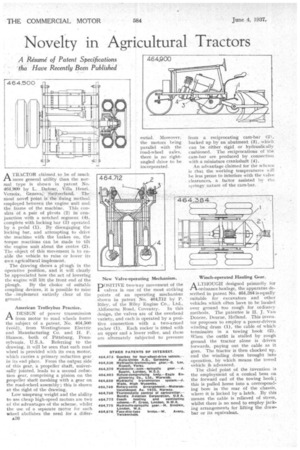Novelty in Agricultural Tractors
Page 62

If you've noticed an error in this article please click here to report it so we can fix it.
A Resume of Patent Specifications tha Have Recently Been Published
AlliACT.OR claimed to be of much. more general utility than the normal type is shown in patent No. 484,900 by L. Dufour, Villa Henri, Versoix, Geneva; -:Swit7.erlanel. The: Most novel point is the fixing method employed between the engine. unit and the frame of the machine. This consists of a pair of pivots (2) in conjunction with a notched segment (44, complete with.locking bar (3) operated by a pedal (1). By disengaging the locking bar, and attempting to drive the machine with the brakes on, the torque reactions can be made to tilt the engine unit about the centre (2). The object of this movement is to enable the vehicle to raise or lower its
own agricultural implement. .
. The drawing shows a plough in the operative position, and it will clearly be appreciated how the act of lowering the engine will lift the front end of the plough. By the choice of suitable coupling devices, it is possible to raise the -implement entirely clear of the ground.
American Trolleybus Practice.
PIA DESIGN of power transmission from motor to road wheels forms the .subject of a patent, No, 464,500 (void), from Westinghouse Electric and Manufacturing Co. and H. F. Hanson, both of Pittsburg, Pennsylvania, U.S.A. Referring to the drawing, it will be seen that each road wheel is provided with its own motor; which carries a primary reduction gear. in its end plate. From the output side of this gear, a propeller shaft, universally jointed, leads to a second reduction gear, comprising a pinion on the propeller shaft meshing with a gear on the road-wheel assembly ; this is shown at the right of the drawing.
Low unspriing weight and the ability to use cheap high-speed motors are two of the advantages of the scheme, whilst the use of a separate motor for each wheel abolishes the need for a differ A36 New Valve-operating Mechanism.
pOSITIVE two-way movement of the valves is one of the most striking points of an operating mechanism shown in patent No. 484,712 by P. Riley, of the Riley Engine Co., Ltd., Aldbourne Road, Coventry. In this design, the valves are of the overhead variety, and each is operated by a positive connection with a two-armed rocker (1). Each rocker is fitted with an upper and a lower roller, and these are alternately subjected to pressure
from a reciprocating cam-bar (2), backed up by an abutment (3), which can be either rigid or hydraulically cushioned. The reciprocations of the cam-bar are produced by connection with a miniature crankshaft (4).
An advantage Claimed for the scheme is that the working temperatures will be less prone to interfere with the valve clearances, a factor assisted by the !-pringy nature of the cam-bar.
Winch-operated Hauling Gear.
ALTHOUGH designed primarily for ordnance haulage, the apparatus described in patent No. 464,384 is equally Suitable for excavators and other vehicles which often have to be hauled over ground too rough for ordinary methods. The patentee is H. J. Van Dooms, Deurne, Holland. This inventor proposes to employ a power-driven winding drum (1), the cable of which terminates in a towing hook (2). When the outfit is stalled by rough ground the tractor alone is driven forwards, paying out the cable as it goes. The tractor is then chocked up, and the winding drum brought into operation, by which means the towed vehicle i advanced.
The chief point of the invention is the employment of a conical boss on the forward end of the towing hook; this is pulled home into a corresponding bore in the rear of the chassis, where it is locked by a latch. By this means the cable is relieved of stress, whilst there is no need to employ jacking arrangements for lilting the drawbar or its equivalent.




























































































